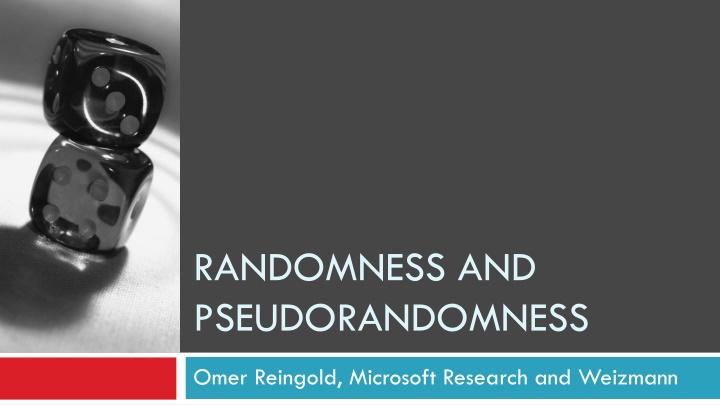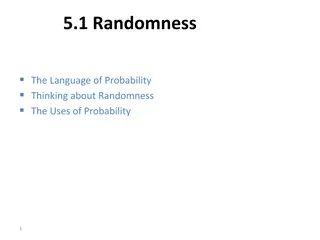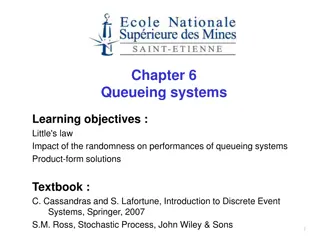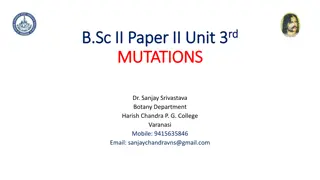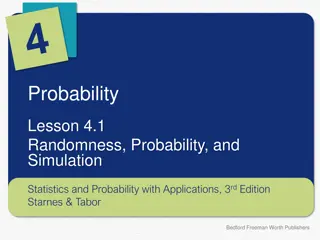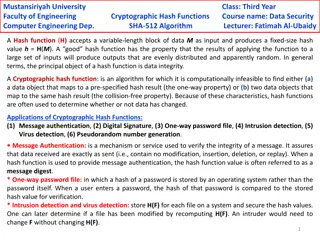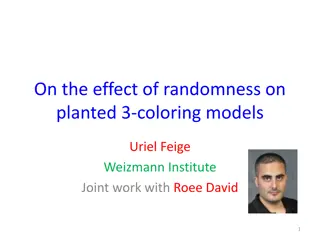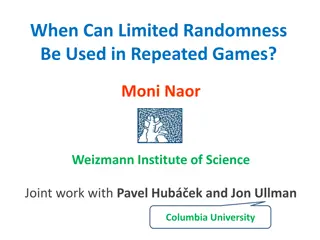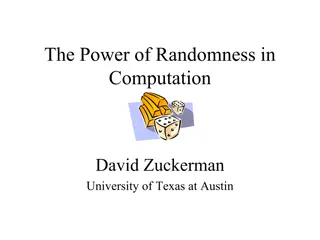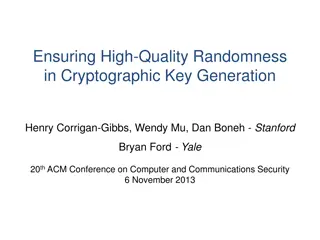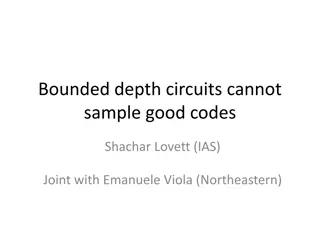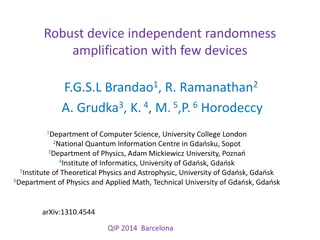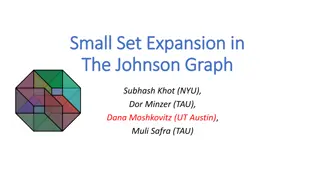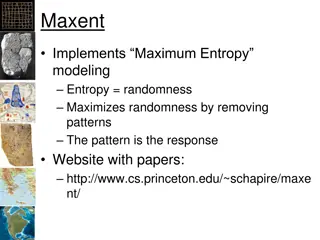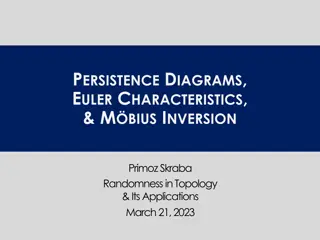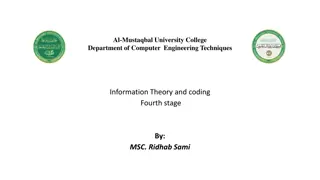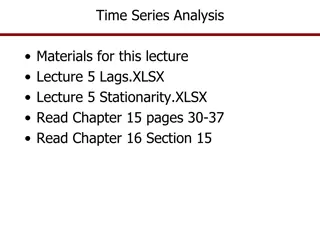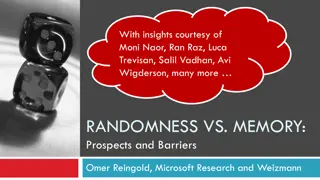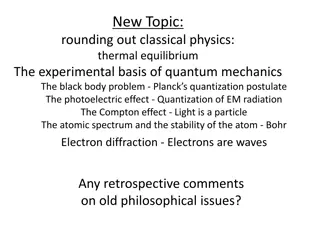Randomness and Pseudorandomness: A Comprehensive Overview
Delve into the realm of randomness and pseudorandomness with insights from Omer Reingold, discussing the utility of randomness, fundamental tools like pseudorandomness, practical applications in computation, distributed computing, and cryptography. Explore how randomness is essential for various algorithms and protocols, emphasizing the significance of balancing randomness and determinism in different contexts.
Download Presentation

Please find below an Image/Link to download the presentation.
The content on the website is provided AS IS for your information and personal use only. It may not be sold, licensed, or shared on other websites without obtaining consent from the author.If you encounter any issues during the download, it is possible that the publisher has removed the file from their server.
You are allowed to download the files provided on this website for personal or commercial use, subject to the condition that they are used lawfully. All files are the property of their respective owners.
The content on the website is provided AS IS for your information and personal use only. It may not be sold, licensed, or shared on other websites without obtaining consent from the author.
E N D
Presentation Transcript
RANDOMNESS AND PSEUDORANDOMNESS Omer Reingold, Microsoft Research and Weizmann
Randomness and Pseudorandomness When Randomness is Useful When Randomness can be reduced or eliminated derandomization Basic Tool: Pseudorandomness An object is pseudorandom if it looks random (indistinguishable from uniform), though it is not. Expander Graphs
Randomness In Computation (1) Can t live without you Distributed computing (breaking symmetry) Cryptography: Secrets, Semantic Security, Sampling, Simulations,
Randomness In Computation (2) You change my world Communication Complexity (e.g., equality) Routing (on the cube [Valiant]) - drastically reduces congestion
Randomness In Computation (3) Do I really need you? In algorithms useful design tool, but many times can derandomize (e.g., PRIMES in P). Is it always the case? BPP=P means that every randomized algorithm can be derandomized with only polynomial increase in time RL=L means that every randomized algorithm can be derandomized with only a constant factor increase in memory
In Distributed Computing Dining Philosophers: breaking symmetry Don t Attack Deterministic Randomized Byzantine Agreement Synchronous t failures t+1 rounds O(1) Asynchronous impossible possible Attack Now
Randomness Saves Communication Deterministic: need to send the entire file! Randomness in the Sky: O(1) bits (or log in 1/error) Private Randomness: Logarithmic number of bits (derandomization). =? Original File Copy
In Cryptography Private Keys: no randomness - no secrets and no identities Encryption: two encryptions of same message with same key need to be different Randomized (interactive) Proofs: Give rise to wonderful new notions: Zero-Knowledge, PCPs,
Random Walks and Markov Chains When in doubt, flip a coin: Explore graph: minimal memory Page Rank: stationary distribution of Markov Chains Sampling vs. Approx counting. Estimating size of Web Simulations of Physical Systems
Shake Your Input Communication network (n-dimensional cube) Every deterministic routing scheme will incur exponentially busy links (in worse case) Valiant: To send a message from x y, select node z at random, send x z y. Now: O(1) expected load for every edge Another example randomized quicksort Smoothed Analysis: small perturbations, big impact
In Private Data Analysis Hide Presence/Absence of Any Individual How many people in the database have the BC1 gene? Add random noise to true answer distributed as Lap( / ) More questions? More privacy? Need more noise. ratio bounded -4 -3 -2 - 2 3 4 0
Randomness and Pseudorandomness When Randomness is Useful When Randomness can be reduced or eliminated derandomization Basic Tool: Pseudorandomness An object is pseudorandom if it looks random (indistinguishable from uniform), though it is not. Expander Graphs
Cryptography: Good Pseudorandom Generators are Crucial With them, we have one-time pad (and more): Without, keys are bad, algorithms are worthless (theoretical & practical) short key K0: 110 derived key K: 01100100 plaintext data: 00001111 plaintext data: (ciphertext K) = 00001111 D E ciphertext = plaintext K = 01101011
Data Structures & Hash Functions If F is random then insertion time and query time are O(1) (in expectation). But where do you store a random function ?!? Derandomize! Heuristic: use SHA1, MD4, Recently (2007): 5-wise independent functions are sufficient* Similar considerations all over: bloom filters, cuckoo hashing, bit-vectors, Linear Probing: Bob Alice F(Bob) Mike Bob Mary
Weak Sources & Randomness Extractors Available random bits are biased and correlated Von Neumann sources: b1 b2 bi are i.i.d. 0/1 variables and bi =1 with some probability p < 1 then translate 01 1 10 0 Randomness Extractors produce randomness from general weak sources, many other applications
Algorithms: Can Randomness Save Time or Memory? Conjecture - No* (*moderate overheads may still apply) Examples of derandomization: Primality Testing in Polynomial Time Graph Connectivity logarithmic Memory Holdouts: Identity testing, approximation algorithms,
(Bipartite) Expander Graphs N N S, |S| K | (S)| A |S| D (A > 1) Important: every (not too large) set expands.
(Bipartite) Expander Graphs N N S, |S| K | (S)| A |S| D (A > 1) Main goal: minimize D (i.e. constant D) Degree 3 random graphs are expanders! [Pin73]
(Bipartite) Expander Graphs N N S, |S| K | (S)| A |S| D (A > 1) Also: maximize A. Trivial upper bound: A D even A D-1 Random graphs: A D-1
Applications of Expanders These innocent looking objects are intimately related to various fundamental problems: Network design (fault tolerance), Sorting networks, Complexity and proof theory, Derandomization, Error correcting codes, Cryptography, Ramsey theory And more ...
Non-blocking Network with On-line Path Selection [ALM] N (Inputs) N (Outputs) Depth O(log N), size O(N log N), bounded degree. Allows connection between input nodes and output nodes using vertex disjoint paths.
Non-blocking Network with On-line Path Selection [ALM] N (Inputs) N (Outputs) Every request for connection (or disconnection) is satisfied in O(log N) bit steps: On line. Handles many requests in parallel.
The Network N (Inputs) N (outputs) Lossless Expander
Slightly Unbalanced, Lossless Expanders N M= N S, | (S)| 0.9 D |S| D |S| K 0< 1 is an arbitrary constant D is constant & K= (M/D) = ( N/D). [CRVW 02]: such expanders (with D = polylog(1/ ))
Property 1: A Very Strong Unique Neighbor Property S, |S| K, | (S)| 0.9 D |S| Unique neighbor of S S Non Unique neighbor S has 0.8 D |S| unique neighbors !
Using Unique Neighbors for Distributed Routing Task: match S to its neighbors (|S| K) S S` Step I: match S to its unique neighbors. Continue recursively with unmatched vertices S .
Reminder: The Network Adding new paths: think of vertices used by previous paths as faulty.
Property 2: Incredibly Fault Tolerant S, |S| K, | (S)| 0.9 D |S| Remains a lossless expander even if adversary removes (0.7 D) edges from each vertex.
Simple Expander Codes [G63,Z71,ZP76,T81,SS96] M= N (Parity Checks) N (Variables) 1 0 0 + + + 0 1 + 1 Linear code; Rate 1 M/N = (1 - ). Minimum distance K. Relative distance K/N= ( / D) = / polylog (1/ ). For small beats the Zyablov bound and is quite close to the Gilbert-Varshamov bound of / log (1/ ).
Simple Decoding Algorithm in Linear Time (& log n parallel phases) [SS 96] N (Variables) M= N (Constraints) 1 0 0 Error set B, |B| K/2 + + 0 | (B)| > .9 D |B| 1 1 1 | (B) Sat|< .2 D|B| |Flip\B| |B|/4 |B\Flip| |B|/4 |Bnew| |B|/2 + 0 1 0 + 0 1 Algorithm: At each phase, flip every variable that sees a majority of 1 s (i.e, unsatisfied constraints).
Random Walk on Expanders [AKS 87] ... x1 x0 x2 xi xiconverges to uniform fast (for arbitrary x0). For a random x0: the sequence x0, x1, x2. . . has interesting random-like properties.
